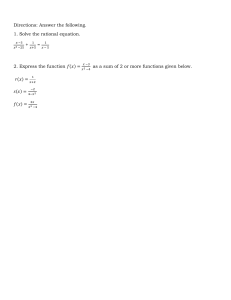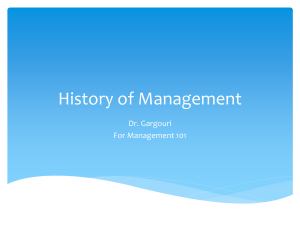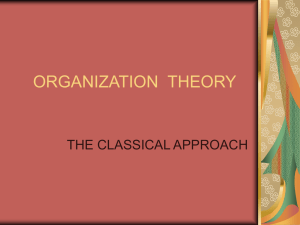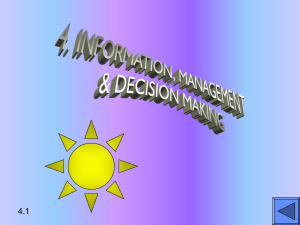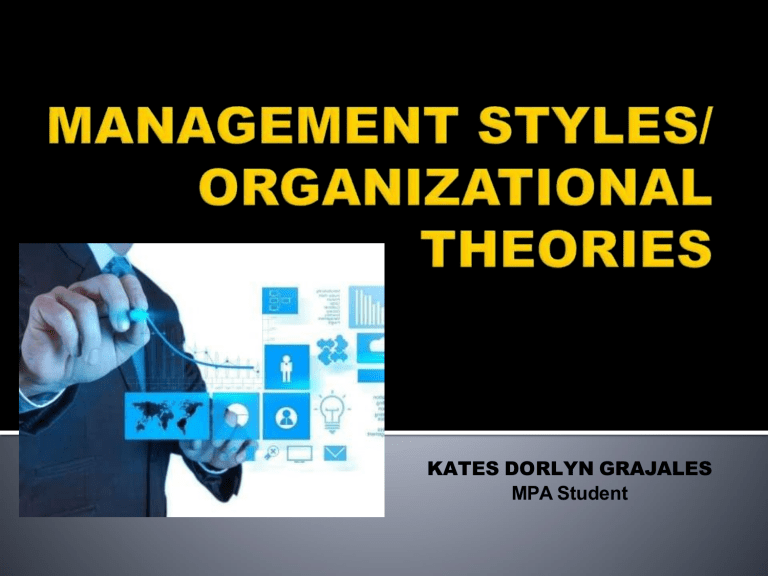
KATES DORLYN GRAJALES MPA Student ◾ MANAGEMENT – the function that coordinates the efforts of people to accomplish goals and objectives by using available resources efficiently and effectively ◾ ORGANIZATION – an organized body of people with a particular purpose, especially a business, society, association, etc. ◾ THEORIES – a set of interrelated propositions that organizes and explains a set of observed phenomenon Classical Organization Theory Neoclassical Organization Theory Modern Structural Organization Theory Organizations exist to accomplish production– related and economic goals. ◾ There is one best way to organize for production, and that way can be found through systematic, scientific inquiry. ◾ Production is maximized through specialization and division of labor. ◾ People and organizations act in accordance with rational economic principles. ◾ ◾ SCIENTIFIC MANAGEMENT APPROACH – based on an idea of systematization where attempts were made to enhance the efficiency of procedure to best effect via scientific analyses and experiments. ◾ ADMINISTRATIVE THEORY – based on several principles of management which is planning, organizing, training, commanding and coordinating function ◾ WEBER’S BUREAUCRATIC APPROACH – considers the organization as a part of broader society STRENGTHS WEAKNESSES ◾ This theory has a narrow ◾ This closed-system, rational focus on improving theory is perhaps too production related economic narrowly focused on goals (strength and production and reduces the weakness). human component to simply ◾ Helped create division of fleshy machines. labor, time and movement ◾ This theory helped invent the studies, and organized industrial revolution, which planning models (such as led to deterioration of POSDCORB). ◾ Attempted to address, and individual craftsmanship; it further, organizational promotes capital intensive functions when few resources economies. existed. ◾ The theory emphasizes individual or group behavior and human relations in determining productivity PRINCIPLES OF NEOCLASSICAL APPROACH ▪ Individual ▪ Work Group ▪ Participative Management STRENGTHS WEAKNESSES ◾ It found “holes” in classical ◾ “The neoclassicalists did not organization theory, develop a body of theory that attempted to revise it, and could adequately replace the spurred almost all other classical school”. It modified schools of thought that it. followed. ◾ “It attempted to blend ◾ De-emphasized simplistic assumptions of classical theory with concepts that mechanistic organizational were subsequently used by theories. ◾ Helped the future later organization theorists from all perspectives” incorporation of professions into organization theory, such ◾ It was an “anti-school” – it couldn’t stand on its own. as sociology. ◾ It is based on the concept that the organization is an adaptive system which has to adjust changes in its environment. ◾ Characteristics of modern approaches to the organization: • Systems viewpoint • Dynamic process of interaction • Multileveled and multidimensional • Multi motivated • Probabilistic SYSTEMS APPROACH – considers the organization as a system composed of a set of interrelated and thus mutually dependent sub-system. SOCIO-TECHNICAL APPROACH – considers the organization as composed of social system, technical system and its environment. CONTINGENGY / SITUATIONAL APPROACH – recognizes that organizational systems are interrelated with their environment and different environments required different organizational relationships for effective working. STRENGTHS ◾ ◾ ◾ ◾ Still very focused (in comparison to classical theory) on goals and achievement. Expanded the perspective of bureaucracy (mechanistic vs. organic). Acknowledges the existence of both formal and informal elements. Still a very rational model, but not as closed of a system as classical. WEAKNESSES ◾ ◾ ◾ ◾ Still a very rational theory. Does not completely address the potential of external influences. Relies on control rather than empowerment. Still considers structure the main tool for making improvements. Human Resource Theory ◾ Organizational Economics Theory ◾ Power & Politics Organizational Theory ◾ Theories of Organizational Culture and Change ◾ Theories of Organization & Environments ◾ • • • • Levels of management Functions of managers Managerial skills Management styles ◾ Management involves the utilization of human and other resources (such as machinery) in a manner that best achieves the firm’s plans and objectives. ◾ According to a recent survey by Shareholder Surveys, shareholders rank good management and long-term vision as the two most important characteristics of a firm. ◾ Top (high-level) management – managers in positions such as president, CEO, CFO and vice-president who make decisions regarding the firm’s long-run objectives. ◾ Middle management – managers who are often responsible for the firm’s short-term decisions. ◾ Supervisory (first-line) management – managers who are usually highly involved with the employees who engage in the day-to-day production process. ◾ Top Management – Set new plan to expand production & increase sales. – Communicate those plans to all managers. ◾ Middle & Top Managers – Determine how many new employees to hire. – Determine how to charge lower prices to increase sales. – Determine how to increase advertising to increase sales. – Determine how to obtain funds to finance the expansion. ◾ Supervisory Managers – Provide job assignments to the new employees who are hired. – Set time schedules for new employees who are hired. ◾ Planning ◾ Organizing ◾ ◾ – the preparation of a firm for future business conditions – the organization of employees and other resources in a manner that is consistent with the firm’s goal. Leading – the process of providing employees with instructions on how they should complete their tasks. Controlling – the monitoring and evaluation of tasks. Top Managers: make the strategic (long-term) plan Communicate the plan to middle management and ask middle management to implement the plan. Middle Managers: Organize the employees and other resources to produce Top Management: Assess the expenses and sales from producing products every month. Determine whether the new strategic plan is successful. Middle Management: Determine whether the production is efficient (based on monitoring the plant’s output and expenses each month) Communicate the organization to supervisors and ask them to implement the production process. Supervisors: Explain each employee’s tasks & how to perform the tasks Supervisors: Monitor employees to ensure their new assignments properly ◾ Conceptual skills (analytic skills) – the ability to understand the relationships among the various tasks of a firm. ◾ Interpersonal skills (communication skills) – the skills necessary to communicate with customers and employees. ◾ Technical skills ◾ Decision-making skills – skills used to perform specific day-to-day tasks – skills for using information to determine how the firm’s resources should be allocated. Democratic Style Autocratic Style Laissez-faire DEMOCRATIC (PARTICIPATIVE) – the manager allows the employees to take part in decision-making: therefore everything is agreed by the majority. (empowerment) this style can be particularly useful when complex decisions need to be made that require a range of specialist skills; from the overall business' point of view, job satisfaction and quality of work will improve. the decision-making process is severely slowed down, and the need of a consensus may avoid taking the 'best' decision for the business. AUTOCRATIC – an autocratic or authoritarian manager makes all the decisions, keeping the information and decision making among the senior management. the direction of the business will remain constant, and the decisions will be quick and similar, this in turn can project an image of a confident, well managed business. subordinates may become dependent upon the leaders and supervision may be needed this style can decrease motivation and increase staff turnover LAISSEZ-FAIRE (FREE-REIN) – the leader delegates much authority to employees; the leader's role is peripheral and staff manage their own areas of the business. the style brings out the best in highly professional and creative groups of employees. the leader therefore evades the duties of management and uncoordinated delegation occurs this leads to a lack of staff focus and sense of direction, which in turn leads to much dissatisfaction, and a poor company image ◾ Management controls or directs people/resources in a group according to principles or values that have already been established. ◾ Leadership is setting a new direction or vision for a group that they follow, ie: a leader is the spearhead for that new direction; Thank You FOLKS ! ! !
